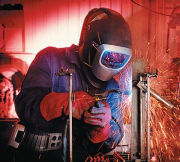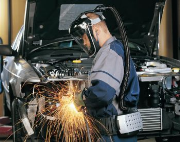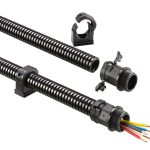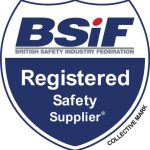 Alan McArthur of 3M discusses the main respiratory hazards posed to welders in their work and how to counter them
Alan McArthur of 3M discusses the main respiratory hazards posed to welders in their work and how to counter them
The hazards that welders have to face in their work are numerous. Optical hazards in the form of ultraviolet (UV), infrared (IR) and visible light, hazards to the skin from metal spatter, heat and UV light, and hearing hazards from noisy welding processes and other activities such as grinding all pose significant problems.
However, not so well known is that welding generates harmful airborne contaminants which can cause significant long term health issues if proper protection is not provided.
Personal protective equipment (PPE) is one of the controls used to reduce the risk of hazards causing harm. However, before employers turn to PPE, they must undertake a full risk assessment and first consider other engineering and administrative controls depending on the specific situation and whether other methods, such as using other bonding techniques, are applicable.
The nature of hazards
Welding uses oxygen during combustion, while other gases present may displace or dilute air. Particle hazards from grinding, paint and other coatings can also be very harmful if proper protection is not provided. This combination of issues means that providing adequate respiratory protection is key.
Respiratory hazards are generated via the high temperatures involved in welding, the action of ultraviolet light on the air, and the presence of coatings and contamination on the metal being welded.
Metal fume is the primary particulate hazard generated during welding and describes particles formed as a result of the intense heat applied to metals.
As metals are heated beyond their boiling point, vapour is given off. This vapour oxidises in the air, cools and condenses into very fine metal oxide particles. The metal fume formed originates mainly from the consumables used, such as electrodes and filler wire, and the base metal. The composition of the fume, and therefore its toxicity, is determined by the metal being welded and electrode used.
 Metal fume from welding stainless steel may contain chromium and nickel – both of which have the potential to cause cancer. However, these materials are unlikely to be present in the fume produced when welding mild steel. Inhaling metal fume leads to welders experiencing metal fume fever.
Metal fume from welding stainless steel may contain chromium and nickel – both of which have the potential to cause cancer. However, these materials are unlikely to be present in the fume produced when welding mild steel. Inhaling metal fume leads to welders experiencing metal fume fever.
This industrial illness typically manifests itself through symptoms similar to flu, such as chills, nausea, thirst, cough and aching limbs. Recovery is swift, generally within 24 hours. However, frequent exposure to zinc fume (usually produced when welding galvanised steel) produces a temporary immunity that is quickly lost, meaning the symptoms are often noticed more on a Monday or after a holiday.
Exposure to metal fume also causes irritation to the nose, throat and lungs, but more concerning are the long term respiratory problems associated with a build-up of scar tissue in the lungs.
Gases and vapours
Harmful and irritating gases such as nitrogen dioxide and ozone are also formed as nitrogen and oxygen in the air react with the ultraviolet light generated during arc welding. The amount of gas generated varies depending on the welding method and the metal.
As coatings burn, carbon monoxide and carbon dioxide are given off. Applying high levels of heat to contaminants such as oils and degreasing agents also generates potentially harmful gases.
Degreasing agents can generate phosgene – a chemical weapon used in the First World War. The workplace exposure limits for different common types of airborne hazard can be obtain from The Welding Institute – www.twi.co.uk.
Controlling exposure
In the UK, airborne hazards generated during welding fall under the requirements of the Control of Substances Hazardous to Health Regulations (COSHH).
In the case of welding, the control typically applied is local exhaust ventilation (LEV) in the form of an extraction system to draw contaminants away from the welder. These systems must be designed properly and inspected and maintained to ensure they function correctly.
Some systems have fixed inlets but welders often use systems with inlets that they position to suit their work. The position of the inlet influences the protection offered, so welders must be trained in the correct use of the system.
PPE in the form of respiratory protective equipment (RPE) is often used as a secondary control measure with an extraction system. In certain situations, for example one-off on-site jobs, RPE may be the primary control measure.
Points to consider
RPE must be adequate and suitable for the work being undertaken, as different types of RPE offer different levels of protection. The RPE must also fit correctly, be comfortable to wear, be robust enough for the environment in which it will be used and be compatible with any other PPE being worn.
RPE broadly breaks down into two types – those that filter contaminants from the air and those that supply clean air from an outside source. The choice between the two will depend on the level and type of contaminants in the air and the preference of the user.
A variety of RPE which is fully compatible with welding shields can be selected, offering protection against the most common types of fume. Specifiers and users can typically choose between disposable and reusable RPE. Consideration must be given to the storage and maintenance of reusable types to ensure both welders and the investment in RPE are protected. Maintenance of RPE will involve ensuring spare parts are available and an administration system to keep records.
While welding presents a range of issues, the availability of clear guidance and state of the art equipment, backed by extensive ongoing research and development, means there is no reason why it cannot be undertaken safely.






